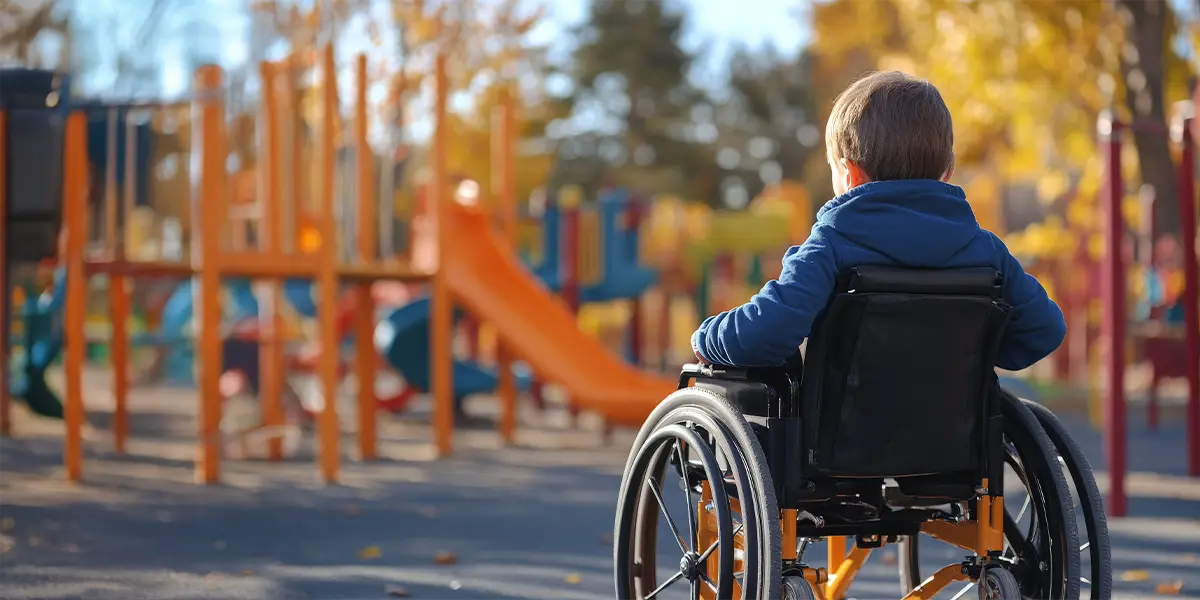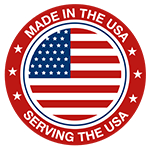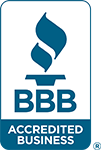Playground Surfaces – ADA Compliance And Safety Standards
The foundation of an inclusive and safe playground is the surface itself. Choosing the right material ensures that children of all abilities can navigate, interact, and play freely, while maintaining critical safety standards. Whether you’re designing a school playground, a public park, or a childcare facility, ADA compliance is not optional — it’s essential.
This guide, based on official guidance from the U.S. Access Board and practical industry experience, will walk you through what ADA compliance means for playground surfaces, how to choose the right material, and what pitfalls to avoid.
What ADA Compliance Means for Playground Surfaces
The Americans with Disabilities Act (ADA) sets federal standards requiring playgrounds to be accessible to children with disabilities. According to the U.S. Access Board’s Guide to the ADA Accessibility Standards, playground surfaces must be firm, stable, and slip-resistant. Beyond general qualities, surfaces must meet technical specifications such as:
- ASTM F1951: Testing for wheelchair accessibility (firmness and stability).
- ASTM F1292: Testing for impact attenuation (critical fall height protection).
Accessible routes must connect play components and surrounding amenities, with running slopes no steeper than 1:16 (6.25%), cross slopes no steeper than 1:48 (2.08%), and no openings wider than ½ inch.
The exact standards apply slightly differently depending on ownership. Public schools, parks, and government facilities fall under Title II of the ADA, while private schools, shopping centers, and daycares fall under Title III. However, the surface accessibility requirements themselves are consistent across both.
Maintaining compliance is a continual obligation — not just at installation, but for the lifetime of the playground.
The Critical Role of Surface Selection
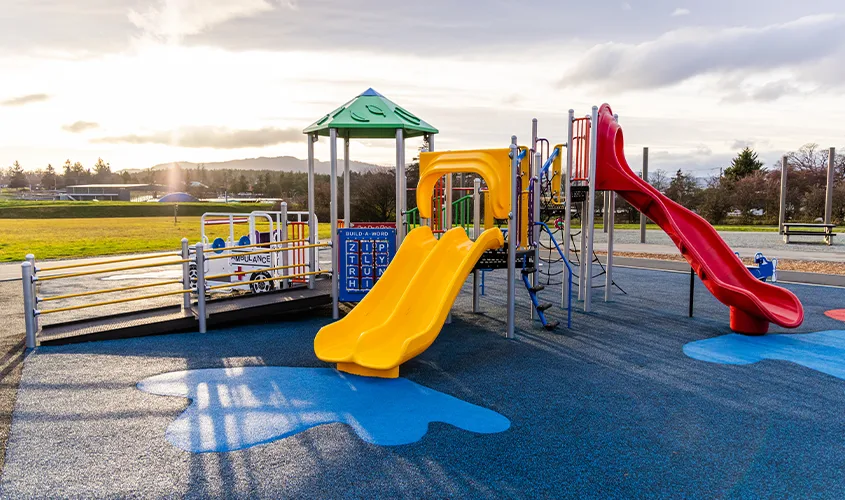
Surface choice determines whether a playground stays accessible over time. Even materials that pass laboratory tests at installation can fail under real-world conditions without careful selection, installation, and maintenance.
Accessibility isn’t just about checking a box — it’s about ensuring that every child, parent, or caregiver, regardless of mobility level, can engage without barriers.
Best Surface Options for ADA Compliant Playgrounds

Poured-in-Place Rubber
Poured-in-place (PIP) rubber is widely regarded as the top choice for accessibility and durability. Its seamless, level surface easily supports wheelchairs, walkers, and other mobility devices, while also offering excellent shock absorption. Installed correctly, it meets both ASTM F1951 and F1292 standards with minimal maintenance.
While PIP rubber comes at a higher initial cost, its long-term performance often makes it the best value over the life of the playground. The U.S. Access Board and the National Center on Accessibility both highlight unitary surfaces like PIP rubber as the most consistent option for long-term compliance.
Synthetic Turf Systems
Synthetic turf, when installed over an ADA-compliant padding system, provides a firm and stable surface while delivering a more natural aesthetic. Although not as perfectly smooth as PIP rubber, modern turf systems are easy to navigate with most mobility devices and resist slipping even when wet.
Turf is especially valuable for larger playfields or open spaces where a “grass-like” appearance is desired without sacrificing safety or usability.
Rubber Tiles
Interlocking rubber tiles offer modularity: if a section wears out or becomes damaged, it can be replaced individually. Properly installed, tiles can form a compliant, shock-absorbing surface. However, seams can present issues over time if they shift or separate, potentially leading to noncompliance.
Regular inspection and skilled installation are key if choosing tiles. The U.S. Access Board’s research emphasizes that while tiles are viable, seam separation and maintenance are critical challenges that must be proactively addressed.
Surfaces with Known Accessibility Challenges
Engineered Wood Fiber (EWF)
Initially, engineered wood fiber can meet accessibility standards when installed and compacted correctly. However, without constant maintenance — including raking, topping off, and compacting — it quickly becomes uneven, unstable, and noncompliant. The Access Board’s 2012 longitudinal study found that EWF had the greatest number of deficiencies within the first year of installation.
In environments like schools where daily heavy use is expected, maintaining EWF to ADA standards often becomes an expensive and labor-intensive commitment.
Rubber Mulch
Rubber mulch performs better than wood fiber in terms of durability, but as a loose material, it still shifts and displaces under heavy use. Accessible pathways may degrade quickly unless meticulously maintained. While rubber mulch may initially pass ASTM F1951 standards, field testing frequently reveals inconsistencies over time.
Loose-fill materials like these demand an ongoing, resource-intensive maintenance plan — something not every operator is prepared to deliver.
Non-Compliant Surfaces
Materials like pea gravel and sand do not meet ADA accessibility requirements under any circumstance and should not be used for public playground surfaces.
Why Ongoing Maintenance Matters
Compliance does not end when the surface is installed. The ADA clearly states that surfaces must continue to meet ASTM F1951 and ASTM F1292 standards for as long as the playground is open to the public.
Maintenance requirements include regular inspections for levelness, firmness, and slope compliance, immediate repairs if surfaces become unstable or separated, and scheduled field testing using methods like the rotational penetrometer (for firmness) and TRIAX (for impact attenuation).
Skipping maintenance not only compromises accessibility but also exposes playground operators to legal and safety risks.
Where ADA Compliance Matters Most
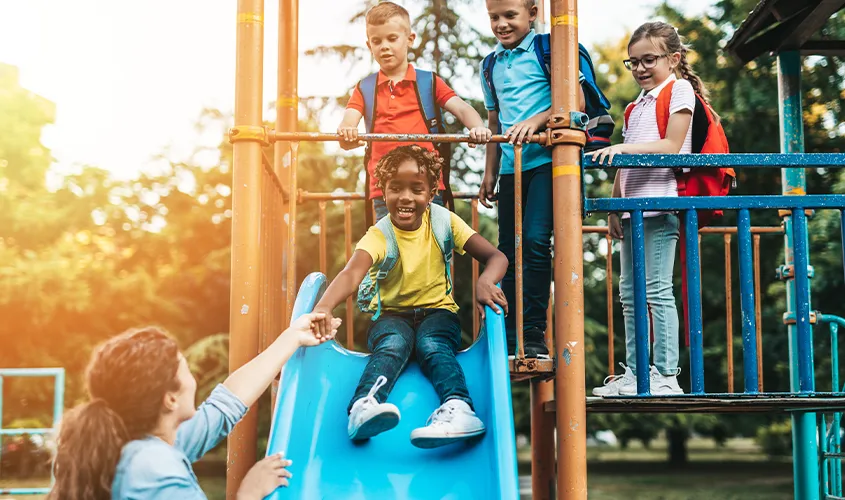
School playgrounds are among the most critical environments for accessibility because they serve children daily — often hundreds or even thousands over a year. The heavy, repeated use places extreme demands on surface materials.
- Related article: Playground Surfaces For Schools – A Complete Guide
While school safety is critical, ADA compliance is equally important in parks, public recreation centers, churches, daycares, and commercial spaces like malls. Any place that offers playground equipment and is open to the public must provide accessible routes and surfaces under ADA Title II or III, depending on ownership.
Surface planning must be forward-thinking — especially in schools — but universally important across all public play spaces.
Smart Planning Tips for an Accessible Playground Surface
Choosing an ADA-compliant playground surface isn’t just about picking a material — it’s about designing a whole system that will perform reliably under real-world conditions.
When planning a surface installation, integrate accessibility from the start, choosing a continuous accessible route connecting all play components, not just isolated patches. Choose materials with proven long-term performance and demand documentation for ASTM testing compliance. Budget for maintenance accordingly: unitary surfaces like PIP rubber and synthetic turf require much less maintenance than loose-fill options. Finally, partner with experienced installers, as poor installation can cause even the best materials to fail.
A surface that looks compliant on opening day is meaningless if it becomes inaccessible a year later.
Conclusion: Building Inclusive Playgrounds That Last
Selecting the right ADA-compliant playground surface is one of the most impactful decisions you can make for an inclusive, safe, and durable play environment.
Unitary surfaces like poured-in-place rubber, synthetic turf, and properly installed rubber tiles offer the strongest long-term compliance with minimal ongoing maintenance. Loose-fill options like engineered wood fiber or rubber mulch may appear budget-friendly initially, but their maintenance demands can quickly erode those savings — and worse, compromise accessibility for the children and families you aim to serve.
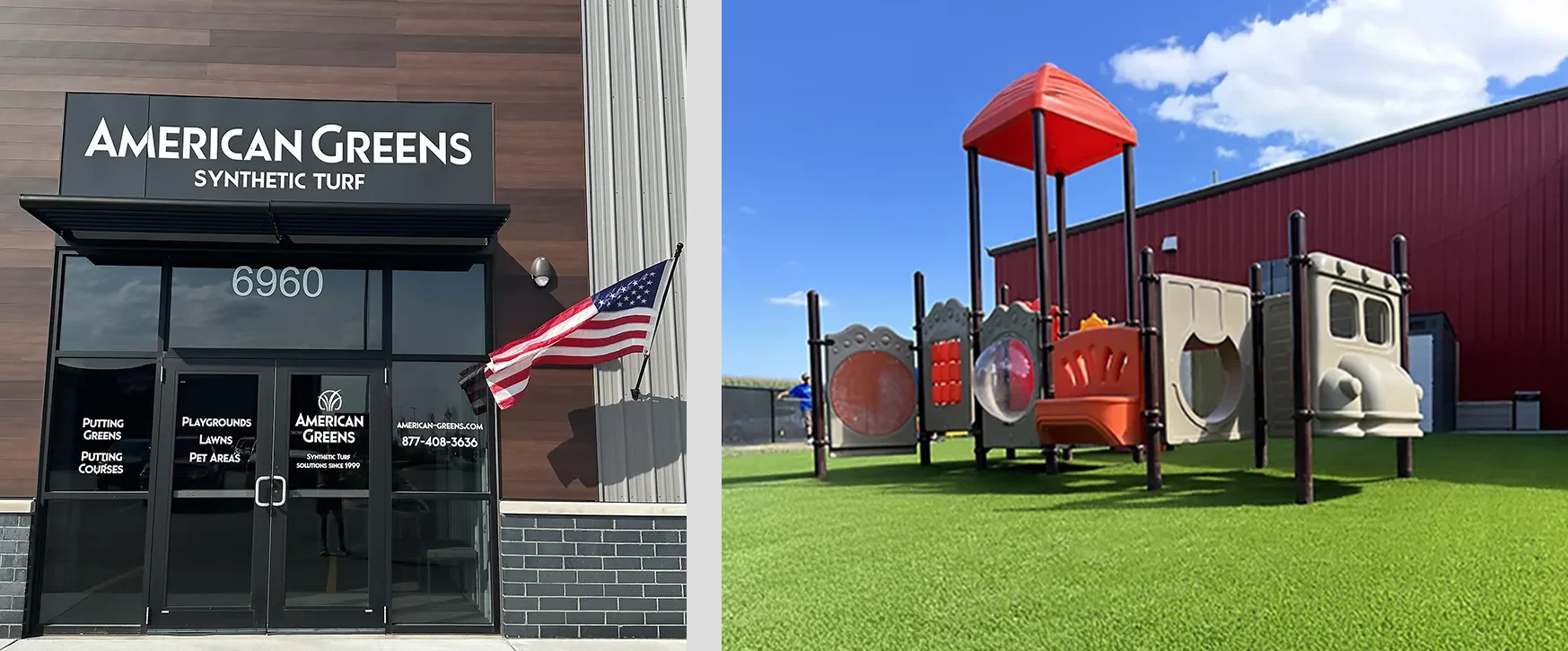
At American Greens, we specialize in developing playground surfacing solutions for schools, parks, and municipalities that exceed ADA accessibility standards and deliver long-lasting performance. Get in touch with us to start planning a surface solution that’s truly inclusive — today, tomorrow, and for years to come.

